by Brian Thomas, Ph.D., and Tommy Lohman*

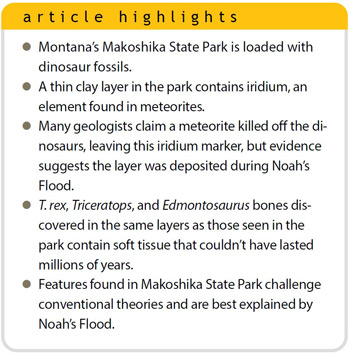 Makoshika State Park, located just southeast of Glendive, Montana, became a state park in 1939. Its badlands feature steepsided, rugged terrain carved from rock strata by extensive erosion. In fact, the park gets its name from the Lakota term mako sica, meaning “bad land.”
Makoshika State Park, located just southeast of Glendive, Montana, became a state park in 1939. Its badlands feature steepsided, rugged terrain carved from rock strata by extensive erosion. In fact, the park gets its name from the Lakota term mako sica, meaning “bad land.”
These lands expose the Hell Creek Formation—a loosely cemented sandstone containing many dinosaur fossils. The layers found here reveal a variety of features that challenge conventional theories about evolution, dinosaur extinction, and ancient ages. They instead support a historical catastrophic flood like the one recorded in Genesis.
Digging for Dinosaurs
Have you ever been on a fossil dig? It’s the ultimate treasure hunt. I (Tommy) have supervised many digs over 13 summers at the Glendive Dinosaur and Fossil Museum property next to Makoshika State Park. It never gets old. These fossils are reminders of the Genesis Flood’s impact on the earth.
The sedimentary rock layers of the Hell Creek Formation (HCF) contain fossils of Tyrannosaurus rex, Triceratops, Edmontosaurus, and other well-known dinosaurs. Within these same layers are also “living fossils” such as crocodilians, turtles, fish (including gar and sharks), small mammals, and remains of modern plants like fern and sequoia. Each of these fossil forms has a living look-alike that shows no evidence of evolution or the millions of years imagined for it to occur. This matches the biblical report in Genesis 1 that God made separate, distinct creature kinds.
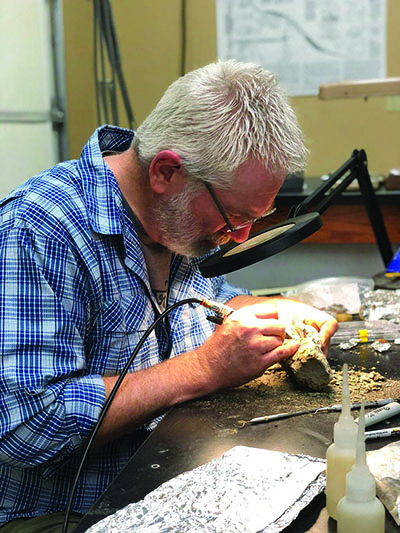
A lot of HCF fossils contain minerals from the burial process, but the detail in many of the bones is still pristine. Blood vessel grooves, foramina, attachment points for tendons/muscles, evidence of cartilage, and the neural canal where the spinal cord once ran are all visible. Since a dead animal’s bones soon lose these details today, rapid burial by the Flood helps explain why they exist in these fossils.
The Flood is also a fitting explanation for the park itself. The depositional phase laid down multiple stratified layers, catastrophically burying broken and twisted bones of creatures that perished in the cataclysm. The later runoff phase carved valleys, as would be expected from Genesis 7–8. According to ICR’s Flood model, the mud and sand from fast-moving flows found at Makoshika were deposited close to the peak of flooding, when “the waters prevailed on the earth one hundred and fifty days.”1
Iridium and Dinosaur Extinction
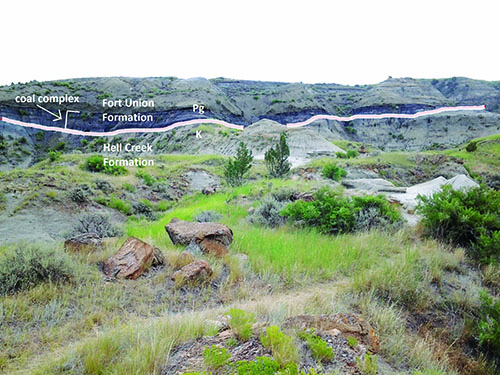
Geologists take interest in a thin clay/coal seam in Makoshika State Park. It appears that this same clay extends for hundreds of miles. It forms a thin, dark line known as the K-Pg (Cretaceous-Paleogene) boundary between the tall, tan sediments of the Hell Creek Formation below and the Fort Union Formation above. This clay contains the element iridium, which is also evident in meteorites. Park signs assert that no dinosaurs were buried above this clay line.
Conventional scientists wove these clues into what has become the most popular dinosaur extinction story. It goes something like this: a meteorite impact killed the dinosaurs eons ago. The collision caused a colossal tsunami that spread clay with iridium like a coat of paint for hundreds of miles. The impact left the 110-mile-wide Chicxulub crater that’s now deep underground at Mexico’s Yucatán Peninsula.
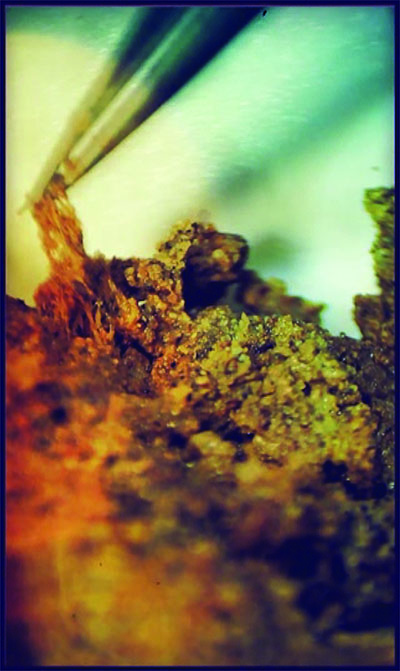
Certain observations run counter to this story. First, Chicxulub isn’t a crater—just a gravity signature based on rock density differences. Second, iridium is largely missing from Chicxulub rocks, even though that was the point of the meteorite’s supposed impact! Finally, any impact that could have wiped out all or most of the dinosaurs should have erased frogs and other creatures, but there are still frog fossils below and above the clay. For all we know, magma intrusion or tectonic forces formed the Chicxulub gravity anomaly.2
Volcanism during Noah’s Flood makes sense of the iridium, since volcanic deposits can have high iridium content. The region’s rocks have volcanic debris sprinkled throughout. According to Scripture, the floodwaters “took [or ‘carried off’]…all” from the land. 3 When “all the fountains of the great deep were broken up,” liquid water and steam mixed within magma made their way up through Earth’s crust—through colossal volcanoes in some places.4
Additionally, the reason dinosaur fossils occur in these particular layers could stem from where they lived in the pre-Flood world, not when they lived in imagined evolutionary time. In other words, as the Flood waters progressed during the Flood year, they would have eventually reached dinosaur areas and buried those creatures before moving farther inland and upland to bury large mammals in upper layers.5
Dinosaur Blood Vessels
Some dinosaur fossils from HCF have still-flexible tissues, including blood vessels found inside the bones. Researchers’ first description of the colors, shapes, and chemistry of proteins and tissues from HCF was based on material from a T. rex femur.6 The Museum of the Rockies houses the bones, nicknamed B-rex after its discoverer, Bob Harmon. A sign there says, “It was the femur of B-rex (MOR 1125) that yielded…soft tissue blood vessels and cells.” The age assigned to these fossils is 67 million years, but decay studies limit protein lifespans to fewer than a million years at today’s temperatures.7 How could such short-lived materials persist for so long?
And B-rex is not a standalone example of soft tissues found in HCF fossils. One article revealed a still-flexible sheet of connective tissue inside a Triceratops horn core.8 Yet another team described blood vessels in six of 20 Edmontosaurus samples.9 These studies fit with over 120 reports of original-looking material from fossils found around the world. 10
To deny the reality of the blood vessels and their proteins is to ignore clear data. Similarly, denying the results of decay rate studies turns a blind eye on equally clear data.11 Although we would not say that dinosaur blood vessels and similar finds “prove” the Bible, assigning these rocks and fossils to the Bible’s age for Noah’s Flood at about 4,500 years ago makes sense of both data sets.
Visitors to Makoshika State Park can feel confident that the Flood, not some meteorite impact, killed and buried these creatures in blanketing sediments. They can even touch the very rocks that contained the first popular discoveries of tissue-bearing fossils that fit the timing of Noah’s Flood so well.
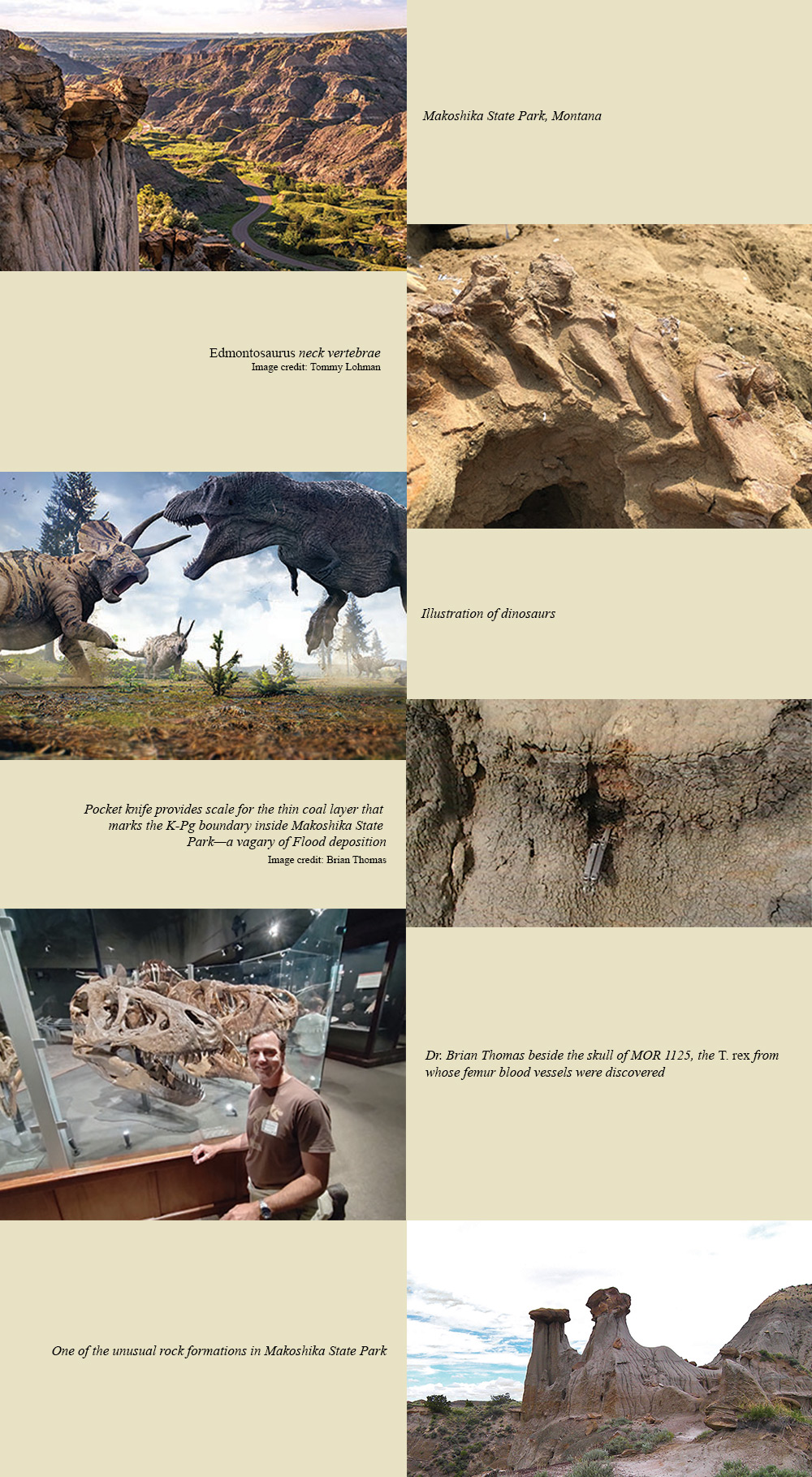

References
- Genesis 7:24.
- Clarey, T. 2017. Do the Data Support a Large Meteorite Impact at Chicxulub? Answers Research Journal. 10: 71–88.
- Matthew 24:39.
- Genesis 7:11.
- Morris, J. 2004. Are Fossils the Result of Noah’s Flood? Acts & Facts. 33 (11).
- Schweitzer, M. et al. 2005. Soft-Tissue Vessels and Cellular Preservation in Tyrannosaurus rex. Science. 307 (5717): 1952–1955.
- Buckley, M. et al. 2008. Comment on “Protein Sequences from Mastodon and Tyrannosaurus rex Revealed by Mass Spectrometry.” Science. 319 (5859): 33.
- Armitage, M. H. and K. L. Anderson. 2013. Soft sheets of fibrillar bone from a fossil of the supraorbital horn of the dinosaur Triceratops horridus. Acta Histochimica. 115 (6): 603–608.
- Ullmann, P. V., S. H. Pandya, and R. Nellermoe. 2019. Patterns of soft tissue and cellular preservation in relation to fossil bone tissue structure and overburden depth at the Standing Rock Hadrosaur Site, Maastrichtian Hell Creek Formation, South Dakota, USA. Cretaceous Research. 99: 1–13.
- Thomas, B. and J. Tay. List of Biomaterial Fossil Papers. Posted on docs.google.com. DOI: 10.13140/RG.2.2.10126.61766.
- Scientists have proposed a few models for preserving protein far longer than their decay rates allow. But since they have not tested these models using bone decay experiments, such proposals remain speculative.
Dr. Thomas is a research scientist at the Institute for Creation Research and earned his Ph.D. in paleobiochemistry from the University of Liverpool. Tommy Lohman and his wife, Martha, serve as dig supervisors for Glendive Dinosaur and Fossil Museum.




